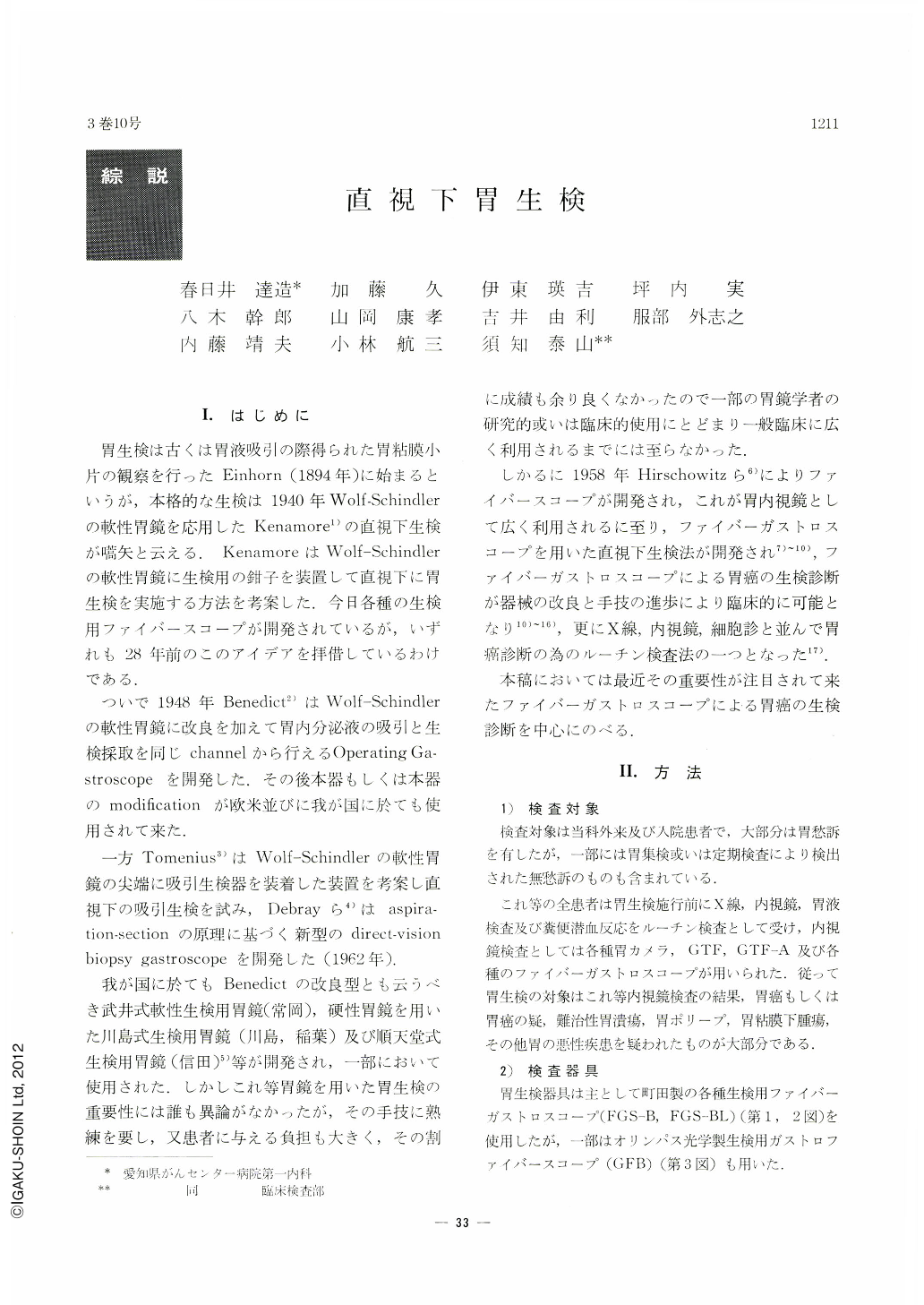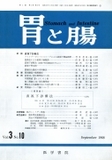Japanese
English
- 有料閲覧
- Abstract 文献概要
- 1ページ目 Look Inside
Ⅰ.はじめに
胃生検は古くは胃液吸引の際得られた胃粘膜小片の観察を行ったEinhorn(1894年)に始まるというが,本格的な生検は1940年Wolf-Schindlerの軟性胃鏡を応用したKenamore1)の直視下生検が嚆矢と云える.KenamoreはWolf-Schindlerの軟性胃鏡に生検用の鉗子を装置して直視下に胃生検を実施する方法を考案した,今日各種の生検用ファイバースコープが開発されているが,いずれも28年前のこのアイデアを拝借しているわけである.
ついで1948年Benedict2)はWolf-Schindlerの軟性胃鏡に改良を加えて胃内分泌液の吸引と生検採取を同じchannelから行えるOperating Gastroscopeを開発した.その後本器もしくは本器のmodificationが欧米並びに我が国に於ても使用されて来た.
一方Tomenius3)はWolf-Schindlerの軟性胃鏡の尖端に吸引生検器を装着した装置を考案し直視下の吸引生検を試み,Debrayら4)はaspiration-sectionの原理に基づく新型のdirect-vision biopsy gastroscopeを開発した(1962年).
我が国に於てもBenedictの改良型とも云うべき武井式軟性生検用胃鏡(常岡),硬性胃鏡を用いた川島式生検用胃鏡(川島,稲葉)及び順天堂式生検用胃鏡(信田)5)等が開発され,一部において使用された.しかしこれ等胃鏡を用いた胃生検の重要性には誰も異論がなかったが,その手技に熟練を要し,又患者に与える負担も大きく,その割に成績も余り良くなかったので一部の胃鏡学者の研究的或いは臨床的使用にとどまり一般臨床に広く利用されるまでには至らなかった.
しかるに1958年Hirschowitzら6)によりファイバースコープが開発され,これが胃内視鏡として広く利用されるに至り,ファイバーガストロスコープを用いた直視下生検法が開発され7)~10),ファイバーガストロスコープによる胃癌の生検診断が器械の改良と手技の進歩により臨床的に可能となり10)~16),更にX線,内視鏡,細胞診と並んで胃癌診断の為のルーチン検査法の一つとなった17).
本稿においては最近その重要性が注目されて来たファイバーガストロスコープによる胃癌の生検診断を中心にのべる.
Studies on gastric biopsy under direct vision had been done with a shooting biopsy, using various gastroscopes, by a few researchers for about the last 28 years. Although it was applied clinically in certain cases, this method did not become a routine diagnostic procedure. However, since a fiberscope was invented by Hirschowitz et al., recently gastric biopsy by the fiberscope has been performed. Gastric biopsy by the fibergastroscope to detect gastric cancer became possible with the advancement of instruments and the improvement of procedures. Furthermore, gastric biopsy under direct vision is becoming a routine procedure for the diagnosis of gastric cancers.
We have been using gastric biopsy under direct vision by the fibergastroscope for small lesions found by the gastrocamera, and recognized a rapid increase in diagnostic accuracy for early stomach cancer. Results of gastric biopsy of our cases with early and advanced gastric cancers are mainly presented.
Materials and Methods
Out-or in-patients with complaints of the stomach and some with no complaints were studied. X-ray and endoscopic examinations, gastric analysis and feces examinations were performed on all patients.
For endoscopic examinations, various types of the gastrocameras, the GTF and GTF-A, and various fibergastroscopes were used. For gastric biopsy, the fibergastroscope B type-FGS-B and FGS-BL as shown in Figure 1 and 2 (made by Machida Co.), and GFB as shown in Figure 3 (made by Olympus Co.) were used.
Results
Ⅰ. Gastric Cancer
(1) Results of gastric biopsy under direct vision.
In 379 proven gastric cancers, 332 cases or 87.6% were diagnosed as cancer by gastric biopsy. In 314 advanced gastric cancers, 272 cases or 86.6% were positive and in 65 early gastric cancers, 60 cases or 92.3% were positive as shown in Table 1.
(2) Relationship between macroscopic classification of gastric cancers and diagnostic accuracy.
Sixty-six lesions from 65 early gastric cancer cases were studied. Negative cases were seen in 2 cases of Ⅱc, and one case each of Ⅱa, Ⅰ and Ⅱc+Ⅲ types as shown in Figure 4.
(3) Relationship between location of the lesions and diagnostic accuracy.
In general, diagnostic accuracy was low in cases of the lesions of the upper body and antrum. Four of five early gastric cancer cases showing unsuccessful results had lesions located in the upper body, cardia and antrum as shown in Figure 5.
(4) Relationship between extension of the lesions and diagnostic accuracy.
No relationship was observed in advanced gastric cancers. In early gastric cancars sized less than 40 mm in diameter, no appreciable difference was observed. Cases with lesions sized more than 40 mm in diameter were all positive as shown in Figure 6.
(5) Relationship between various areas in the lesion and diagnostic accuracy.
A total of 331 early gastric cancer biopsy specimens were studied. The suitable areas to obtain positive diagnosis were the elevated area (Ⅱa), the inside of the elevated wall of the ulcer, the edge of the depressed area, and the depressed area (Ⅱc) as shown in Figure 7.
(6) Relationship between numbers of specimens and diagnostic accuracy.
The number of specimens 2 to 8 in each case. In most of the cases 3 to 6 specimens were teken. The relationship between the number of specimens and diagnostic accuracy was insignificant as shown in Figure 8.
(7) Relationship between the size of the specimens and diagnostic accuracy.
In early gatsric cancers the degree of positive diagnosis tended to become higher in proportion to the size of the specimen as shown in Figure 9.
(8) Relationship between depth of the specimens and diagnostic accuracy.
The percentage of diagnostic accuracy by biopsy in early gastric cancers was 76.2% in the specimens including the muscularis mucosae, and 56.5% in the specimens of the lamina propria mucosae only. Specimens consisting of necrotic material and blood clot were always negative as shown in Figure 10.
(9) Results of gastric biopsy by various instruments.
Results of gastric biopsy were improved in accordance with improvement of the instrument, especially with employment of an angle as shown in Figure 11. Usefulness of the angle mechanism was indicated by no negative in all biopsy cases of early gastric cancer, even in the cardiac region and the antrum as shown in Table 2.
(10) Unsuccessful gastric biopsy, and the rate of successful gastric biopsy and correct diagnostic accuracy of gastric biopsy against the gastrocamera examination (Table 3).
Ⅱ. Gastric diseases excluding gastric cancer.
Correct or suspicious diagnosis for four cases of reticulosarcoma of the stomach were obtained by biopsy. Biopsy diagnosis has been performed for gastric ulcer, gastric polyp, submucosal tumor, giant rugae, gastritis, erosive gastritis, reactive lymphoreticular hyperplasia, etc.
Follow-up studies of gastric ulcer, gastric polyp and protruded lesion of the stomach were performed periodically. Histologically correct diagnosis was not obtained even by gastric biopsy in two cases of stomach syphilis, however, diagnosis as advanced gastric cancer obtained by X-ray and endoscopic examinations was not affirmed and finding of chronic inflammation suggesting syphilis was obtained by gastric biopsy only.
In sixty-six postoperative stomach cases 6 cases were diagnosed as recurrent gastric cancer by biopsy.
Follow-up study of ATP or a borderline case by biopsy is one of the most reliable methods clinically to clarify a problem of carcinogenesis in the stomach.
Touch smear cytology applying a gastric biopsy specimen.
In seventy proven gastric cancers 67 or 95.7% were positive by touch smear cytology applying a gastric biopsy specimen. This is also a useful cytologic method to afford diagnostic accuracy.
Ⅲ. Comparison of the results of early gastric cancers by both gastric biopsy and lavage cytology under direct vision.
Sixty-two cases of early gastric cancer investigated by both gastric biopsy and lavage cytology under direct vision were studied. Negative cases were seen in I, Ⅱc, Ⅱc+Ⅲ types by biopsy and in Ⅱc+Ⅲ types by gastric lavage cytology.
Concerning the relationship between location of the lesions and negative cases, negative cases by biopsy were mainly seen in the lesions located in the upper body and antrum in which performance of biopsy was difiicult and negative cases by cytology were seen in the lesions of the anterior wall of the lower body and the lesser curvature of the antrum near the angulus as shown in Figure 12. There was no case negative by both methods and diagnostic accuracy was obtainable by at least one of them.
Case Studies
Case 1: A 62-year-old man. X-ray examination of the stomach revealed an irregularly shaped small barium collection in the antrum. Endoscopy showed a small depressed lesion of the Ⅱc type of early gastric cancer on the anterior wall of the antrum as shown in Figure 13. Gastric biopsy under direct vision showed cancer tissue as shown in Figure 14. Gastric lavage cytology under direct vision was also positive. He received gastrectomy by the method of Billroth 1. The resected stomach had a small depressed lesion 8×8mm in dimensions on the anterior wall of the antrum with an irregularity of the ulcer margin as shown Figure 15. Microscopic examination revealed that the dimensions of cancer tissue was 8×3 mm and cancer cell infiltration was limited within the mucous membrane as shown in Figure 16. Its pathological classification was adenocarcinoma tubulare as shown in Figure 17.
Case 2: A 67-year-old man. Endoscopy revealed a small protruded lesion with a slightly depressed area partly of the Ⅱa+Ⅱc type of early gastric cancer on the posterior wall near the angulus in the antrum as seen in Figure 18. Also, there was a small lesion on the posterior wall of the antrum, hemispherical in shape, and classified as a stomach polyp. Gastric biopsy under direct vision revealed cancer tissue as shown in Figure 19, and gastric cytology was positive. Examination of the resected specimen showed a small protruded lesion 10 mm in dimensions on the posterior wall and a small polyp on the posterior wall of the antrum as shown in Figure 20. Microscopic examination of the former lesion showed cancer cell infiltration limited within the gastric mucosa for the most part, but with some invasion into the submucosa as shown in Figure 21. Its pathological classification was adenocarcinoma tubulare as seen in Figure 22. Atypical epithels were observed in the lesion of the polyp in the antrum microscopically.
Conclusion
Gastric biopsy under direct vision by the fibergastroscope is one of the most reliable methods as a clinical diagnostic procedure to detect gastric cancer, especially early gastric cancer. Furthermore, gastric biopsy is also applied to diagnose a sarcoma, and malignancy of gastric ulcer and gastric polyp. Follow-up studies of gastric ulcer, gastritis, especially of a borderline case is another important function of gastric biopsy.
As this is a histological diagnosis, this method is only a preoperative procedure to procure a definite diagnosis.
Combined employment of gastric biopsy and cytology under direct vision negates their weak points. Furthermore, these two methods combined with endoscopic and roentgenologic examinations increased the accuracy of diagnosis.

Copyright © 1968, Igaku-Shoin Ltd. All rights reserved.


